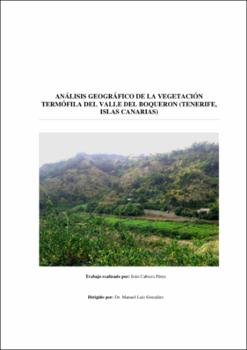Análisis geográfico de la vegetación termófila del Valle del Boquerón (Tenerife, Islas Canarias)
Análisis geográfico de la vegetación termófila del Valle del Boquerón (Tenerife, Islas Canarias)
Autor
Cabrera Pérez, IvánFecha
2016Resumen
Este trabajo es un análisis fitogeográfico de la vegetación termófila canaria que
abarca las montañas del Valle del Boquerón. Tiene como finalidad definir las unidades
internas en las que se articula esta vegetación y esclarecer los factores ambientales que
las determinan. El modelo de organización de las unidades vegetales se encuentra
fundamentalmente determinado por la influencia que los factores topoclimáticos locales
(altitud y orientación) introducen en los vientos dominantes del NE. Junto a ellos,
también se hacen notar los efectos de la pendiente y la acción humana. Esto va a
provocar que la vegetación termófila pueda variar su distribución en función de la
orientación y la altitud fundamentalmente. That elaboration is the analysis phytogeographical of thermophile vegetation of
Canary Islands that include the Valley of Boquerón. The aim of the elaboration is to
define internal elements in which articulate that kind of vegetation and also clarifying
factors of environment that determine the presence of thermophile vegetation. The
model of organization of plants units determinate basically in the influence of
topoclimatic factors (altitude and orientation) that introduce the prevailing winds from
NE. Along with them, we can also notice the effects of the slope and the human action.
The consequence of those factors is that the vegetation thermophile changes own
distribution in function of orientation and the altitude basically.




